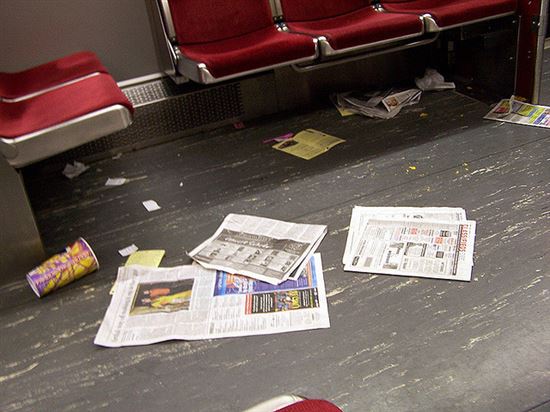23 Littering Statistics That Will Blow Your Mind
In America alone, more than 250 million tons of trash is produced each year, some of which is discarded as litter along roads, on city streets, in parks and across the nation's waterways. Read on for 23 littering statistics that will blow your mind.
Littering not only diminishes the physical beauty of the world we live in, but it also poses some major problems for the people, plants and animals who are affected by it.
If you've ever been guilty of littering, you may not realize just how much of an impact it has, both environmentally and financially. Even if you don't see any immediate consequences, there's still a trickle-down effect, since things like water pollution are often linked to littering and dumping.
The next time you're tempted to just toss that empty drink bottle out of the car window or leave a cigarette butt lying around, keep these astounding littering statistics in mind.
 |
| © Diego Torres Silvestre (CC BY 2.0) via Flickr |
1. The U.K. has the worst reputation for littering
Despite being a world leader, the United Kingdom is struggling with keeping its cities and neighborhoods clean. An astonishing 62% of England's residents admit to dropping trash in the street from time to time.
2. But it's actually on the decline here at home
Although it continues to be a pervasive problem, littering is occurring less frequently than it used to. Over the last 40 years, the litter rate has actually declined by 61% in the U.S.
3. Nearly half of Americans admit to littering
Despite being bombarded with media campaigns that warn about the dangers of littering, may Americans aren't heeding the message. Approximately 43% of people in the U.S. admit to littering at least once.
4. U.S. highways are a prime dumping spot for litter
Drive along any road in the country and you'll likely see aluminum cans, paper products and other trash. Altogether, it adds up to around 52 billion pieces of litter cluttering up the landscape. That breaks down to more than 6,700 items per mile.
5. One item is littered more often than any other
Smokers are major contributors to the littering problem in the U.S. Tobacco waste, including cigarette butts, accounts for 38% of all litter found along roadways and at transition points, such as outside buildings where smoking isn't allowed.
6. Paper products come in a close second
Food wrappers, paper bags, cardboard boxes, newspapers and scrap paper are just some of the things you'll see when you're cruising down the road. Paper products make up 22% of the litter that's currently out there, with plastics landing in third place at 19%.
7. Drivers litter the most
All of the trash found along roadsides needed help to get there. While some of it comes from walkers and cyclists, motorists account for 53% of all litter produced annually.
8. But beach goers aren't helping any either
A day at the beach may not be so pleasant if you're surrounded by litter. In 2012, more than 10 million pounds of trash was collected from beaches and waterways in 97 countries during a global cleanup effort.
9. Tobacco and plastics make up the bulk of beach litter
Over half of the beach trash picked up in 2012 consisted of cigarette butts and filters, food wrappers, plastic bottles and plastic bags. Some of the more oddball things found along the coasts include over 4,000 candles, 236 toothbrushes and 117 mattresses.
10. The world's oceans hide a staggering amount of litter
Pinning down the exact amount of trash that can be found in the world's oceans is difficult. In terms of just plastic litter, conservative estimates put the total amount at roughly 300 billion pounds.
11. More is added each year
Ocean pollution is most often the result of trash being dumped from the land, but marine littering isn't uncommon. An estimated 1.4 billion pounds of litter winds up in the oceans each year.
12. Most of it sinks
The ocean floor is home to a number of sea plants and animals that often find themselves surrounded by trash. Of the billions of pounds of litter that end up in the world's waterways, 70% sinks straight to the bottom.
13. But some of it doesn't
The litter that's swirling around on the surface of the oceans is moved by the currents, which helps to consolidate it into floating trash heaps. One of the largest, the Great Pacific Garbage Patch, is estimated to be anywhere from 270,000 to 5.8 million square miles in size.
14. And it's not going away any time soon
While paper and wood products biodegrade at a moderately fast pace, plastics and other synthetic materials are notorious for being slow to break down. Just one plastic bottle can take 450 years to decompose, while a fishing line can take up to 600 years to disappear.
15. Marine birds and animals are paying the price
Birds, fish and other ocean-dwelling animals are often unable to distinguish between trash and food. As a result, 1 million sea birds and 100,000 marine mammals die each year after becoming entangled in or ingesting litter.
16. That's not the only cost of littering
Littering doesn't just take a toll on things like water and soil quality; there's also an economic cost. Between clean-up efforts, decreases in property values and medical expenses associated with treating illnesses caused by litter, the cost adds up to $11.5 billion each year.
17. Most littering is done intentionally
While littering can occur accidentally, it's most often a deliberate act. Approximately 81% of littering is done with intent, either by someone dropping, flicking or flinging the piece of trash in question.
18. Younger people are more likely to be litterbugs
Age and maturity seem to play a part in determining whether someone will be a litterer. Those under 19 are the most frequent culprits, while adults aged 21 to 35 are three times more likely to litter than the 50-and-up crowd.
19. Men litter more often than women
In addition to age, gender also appears to have an impact on littering rates. The gap is relatively small, however, with 21% of men in the U.S. guilty of littering, compared to 15% of women.
20. Some states are cleaner than others
Although no state can claim to be 100% litter-free, some fare better than others. In terms of how clean its public spaces are, the state of Washington is the best overall while South Carolina is the worst litter offender.
21. Roadway litter can be deadly
While most of the litter that hits the highway comes from being tossed out of car windows, a small percentage is the result of things falling off the backs of trucks or other vehicles. In 2010, there were 440 fatalities related to this kind of road debris.
22. Littering could mean jail time in certain states
In most states, littering can earn you a fine ranging from a few hundred to a few thousand dollars, but some places take it a little more seriously. In 23 states, including Florida, Louisiana, Texas and Washington, littering offenses may be punishable by a stint in jail.
23. Recycling could combat the problem
The average person produces about 4.4 pounds of garbage each day. While 75% of the waste we produce is recyclable, only about 30% actually makes it to a recycling center.
If that were increased, it could drastically cut down on the amount of trash that winds up as litter. Alternatively, you can also help cut down on trash by repurposing or even selling your unwanted items.
Sources and References
- Keep America Beautiful
- Ocean Conservancy
- Keep Britain Tidy
- 5 Gyres
- National Ocean and Atmospheric Administration
- National Geographic
- Kimo International
- Environmental Protection Agency
- Clean Our Oceans Refuge Coalition
- American State Litter Scorecard
- National Highway Traffic Safety Administration
- National Conference of State Legislatures
Rebecca Lake is a journalist at CreditDonkey, a credit card comparison and reviews website. Write to Rebecca Lake at rebecca@creditdonkey.com. Follow us on Twitter and Facebook for our latest posts.
Note: This website is made possible through financial relationships with some of the products and services mentioned on this site. We may receive compensation if you shop through links in our content. You do not have to use our links, but you help support CreditDonkey if you do.
